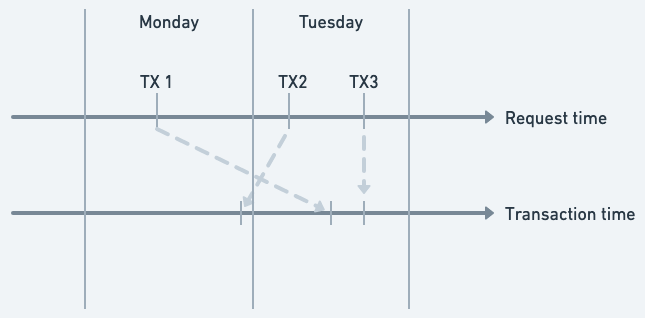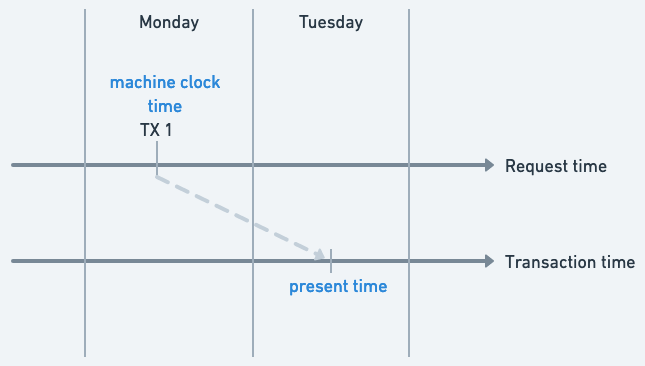Bi-Temporality
This page covers the bi-temporality feature of the ledger as well as the impact of that feature on the ledger's data and the queries that can be run against it.
Definition of bi-temporality
The ledger supports bi-temporality, which means that each transaction is associated with two timestamps:
- Request time: The time at which the transaction was submitted to the ledger. It is usually the machine clock time.
- Transaction time: The time at which the transaction is considered to have occurred.
The ledger records both timestamps for each transaction, and the transaction time is used to determine the state of the ledger at a given point in time.
Let's consider the following example to illustrate the difference between the two timestamps.

In this example, 3 transactions are submitted to the ledger at different times:
TX1is submitted on monday, but the transaction time is set to tuesday. The transaction is considered to have occurred on tuesday. We say that the transaction is postdated.TX2is submitted on tuesday, and the transaction time is set to monday. The transaction is considered to have occurred on monday. We say that the transaction is backdated.TX3is submitted on tuesday, and the transaction time is set to tuesday. The transaction is considered to have occurred on tuesday. This is the default behavior.
Bi-temporality is useful in the following scenarios:
- Time travel: The ability to query the ledger as it was at a specific point in time.
- Correction of errors: The ability to correct errors in the ledger by backdating or postdating transactions.
- Auditing: The ability to audit the ledger at a specific point in time.
- Data import: The ability to import data from external systems that use different timestamps.
Present time relativity
Because transactions can either be backdated or postdated, the concept of "present time" may not match the current machine clock time. Form the point of view of the ledger, the present time is the transaction timestamp the most in the future.
In the example above, let's consider that we only inserted TX1. In that case, the machine clock is on monday, but the present time is tuesday because the transaction time of TX1 is tuesday and it is the most recent transaction.

Likewise, if we insert only backdated transactions, the present time will be in the past compared to the machine clock.
Implications of bi-temporality
Bi-temporality allows users to insert transaction at any point in time in the past or future. When a user performs a query on the ledger, the ledger state is determined based on the requested point in time. The ledger state is a snapshot of the ledger at the requested point in time, and it includes all transactions that have a transaction time equal to or less than the requested point in time.
This capability has some implications discussed below.
From now on, we will only consider the transaction time when discussing the ledger state at a specific point in time.
Account and Transaction Metadata
Account and transaction metadata are not fixed in time. When a user queries the ledger at a specific point in time, the metadata associated with accounts and transactions is also determined based on the requested point in time. This means that the metadata associated with an account or transaction can change over time.
Example: Fraud management
Let's consider the following example. Suppose that a fraud engine is integrated with the ledger to flag suspicious account. It does so by adding risk=high to the account metadata. The fraud team regurlarly exports the suspicious accounts to an external system for further investigation. The fraud team queries the ledger at specific points in time to get the list of suspicious accounts.
Let's consider the account customer:123456. At a time t1 the fraud engine marks the account as suspicious by adding risk=high to the account metadata. The fraud team exports the list of suspicious accounts at time t2 and t3. The account will be included in the list of suspicious accounts in both exports.

Now, let's consider that the fraud engine removes the risk=high metadata from the account at time t4 located between the two exports t2 and t3. It does so by removing the risk metadata using a backdated transaction. In this case, the account will not be included in the list of suspicious accounts in the export at time t3.

Backdated transaction validation
Problem Statement
When a user inserts a transaction with a transaction time in the past, there is a risk that the transaction is invalid because it might yield an invalid state of the ledger.
Consider the following example account whose balance evolution is as follows:
| Time | Transaction amount | New Balance |
|---|---|---|
| 1 | 100 | 100 |
| 2 | -50 | 50 |
| 3 | -10 | 40 |
| 4 | 50 | 90 |
| 5 | -10 | 80 |
Now, consider that a user wants to insert a backdated transaction with a transaction time of 2 and an amount of -100. This transaction would yield the following balance evolution:
| Time | Transaction amount | New Balance |
|---|---|---|
| 1 | 100 | 100 |
| 2 | -100 | 0 |
| 3 | -50 | -50 |
| 4 | -10 | -60 |
| 5 | 50 | -10 |
| 6 | -10 | -20 |
The new balance at time 6 is -20, which is invalid because the account has a negative balance. This is an example of an invalid backdated transaction.
Now, consider that a user wants to insert a backdated transaction with a transaction time of 2 and an amount of -50, rather than -100. This transaction would yield the following balance evolution:
| Time | Transaction amount | New Balance |
|---|---|---|
| 1 | 100 | 100 |
| 2 | -50 | 50 |
| 3 | -50 | 0 |
| 4 | -10 | -10 |
| 5 | 50 | 40 |
| 6 | -10 | 30 |
The new balance at time 6 is 30, which is valid because the account has a positive balance. This is an example of a valid backdated transaction.
Note that the intermediate balances might be negative, as it is the case at time 4 in the second example. The ledger does not validate the intermediate states of the ledger, only the final state.
Validation Mechanism
The ledger does not validate backdated transactions the same way it validates usual transactions. To check that a backdated transaction is valid, the ledger computes the new current state of the ledger by applying the backdated transaction and all the transactions that occurred after the backdated transaction. If the new state is valid, the backdated transaction is accepted. Otherwise, the backdated transaction is rejected.
A backdated transaction is considered valid if it doesn't put any account in a negative balance in the new computed final state of the ledger. Keep in mind that the ledger does not validate the intermediate states of the ledger, only the final state.
The only exception to this rule is the accounts that have been allowed to overdraft within the transaction. These accounts can have a negative balance in the new computed final state of the ledger.